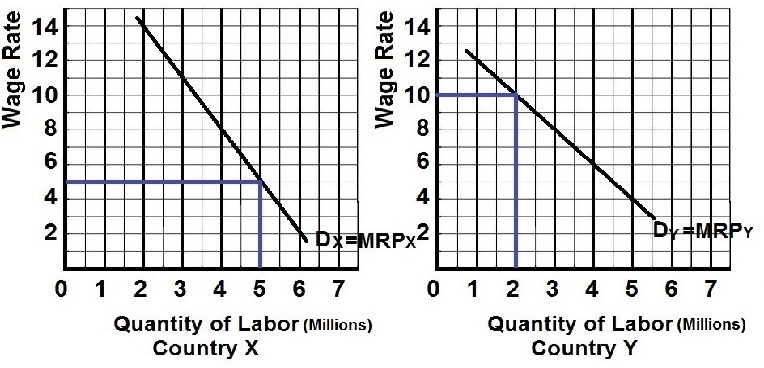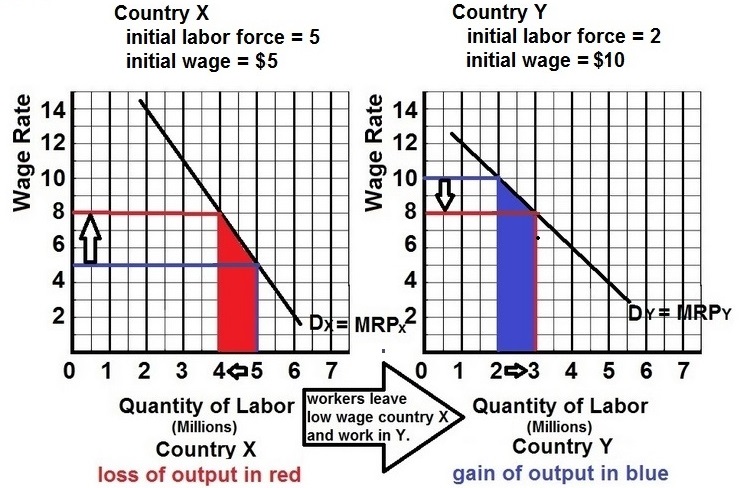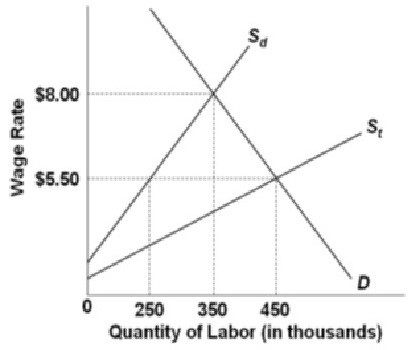|
Economic Effects of Immigration -
The Simple Immigration Model

See the assumptions below, then
answer these questions:
1. How many will migrate
from the low wage country X to the high wage country
Y?
2. What happens to the wage rate in X and in Y?
3. What happens to output in X, in Y, and total
output?
4. What would happen to output if initially there was
unemployment in low wage country X?
5. How do remittances affect low wage country
X?
Assumptions:
1. Dx is the demand for
labor in country X. Dy is the demand for labor in country
Y.
2. Before migration the labor force in country X is 5 and
the labor force in country Y is 2.
3. Neither country has any unemployment.
4. Migration (1) has no costs, (2) occurs only in
response to wage differentials, and (3) is unimpeded by
law in both countries.
5. Labor markets and product markets are competitive so
DL
= MRP = VMP = P x MP
Answer:

Impact of Illegal workers in a Low
Wage Market - The Illegal Immigration Model

MULTIPLE CHOICE:
Assumptions:
1) Employers in this
market are willing and able to ignore minimum wage
laws;
2) Sd represents the supply of domestically-born and
legal immigrant workers;
3) St represents the total supply of workers in this
labor market (St = Sd + illegal immigrants);
4) Unless otherwise stated, illegal immigration is not
effectively blocked by the government.
1. Refer to the above figure. The
equilibrium wage and level of employment are, respectively:
1. $5.50 and 250,000
2. $5.50 and 350,000
3. $8.00 and 350,000
4. $5.50 and 450,000
2. Refer to the above figure. How
many domestically-born and legal immigrant workers will be
hired at equilibrium?
1. 200,000
2. 250,000
3. 350,000
4. 450,000
3. Refer to the above figure. How
many illegal immigrant workers will be hired at equilibrium?
1. 200,000
2. 250,000
3. 350,000
4. 450,000
4. Refer to the above figure. If the
government effectively prevents illegal immigrants from
working in this labor market, the equilibrium wage and level
of employment are, respectively:
1. $5.50 and 250,000
2. $5.50 and 350,000
3. $8 and 350,000
4. $5.50 and 450,000
5. Refer to the above figure. Assume
initially that government does not effectively block illegal
immigration. If the government then finds a way to prevent
all illegal immigrants from working in this labor market:
1. 100,000
domestically-born workers will gain employment at the
expense of 200,000 illegal immigrants.
2. 200,000 domestically-born workers will gain employment
at the expense of 200,000 illegal immigrants.
3. 100,000 domestically-born workers will gain employment
at the expense of 250,000 illegal immigrants.
4. 100,000 domestically-born workers will gain employment
at the expense of 100,000 illegal immigrants.
|